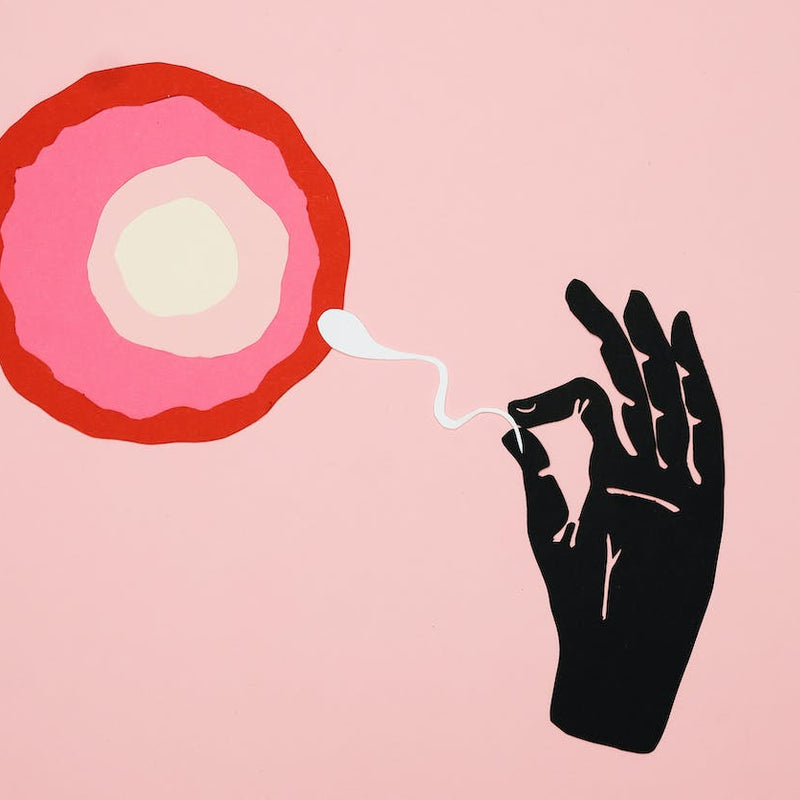Lube and Vaginal Health

Personal lubricant can be a great addition to the bedroom, but it may have negative effects on vaginal health. Read on to learn more about lube, pH, and sexual health.
By fertility expert and OBGYN Dr. Kenosha Gleaton
Whether you’re trying to conceive (TTC), preventing pregnancy, currently pregnant, or postpartum, personal lubricant can be a fun way to increase comfort and reduce friction during sex. It’s also important to choose a lube that won’t harm or irritate the vagina.
Lube Basics
Lube may be a valuable tool for anyone that is sexually active, regardless of gender or sexual orientation. Lube may be especially beneficial for anyone dealing with vaginal dryness or general concerns of burning, rubbing, and other discomfort during sex. There are a few things you need to know about lube before you bring it into the bedroom; here are some of the basics.
Types of Lube
Lube is categorized as water-based, oil-based, or silicon-based. Water-based lubricants are the most commonly found and may or may not include glycerin, an ingredient regularly found in flavored or warming lube. Oil-based lubricants can erode latex, not ideal for those using latex condoms for pregnancy or STI prevention. Silicon-based lubricants are waterproof and safe for use with condoms, however, silicon lube can erode other silicon-made devices (wink wink).
Added Ingredients In Lube
Another thing to be aware of when shopping for lubricants is certain added ingredients. This includes parabens, dye, and sometimes artificial flavors. Flavored lube can be a fun addition for some, but should not be used in or around the vagina as glycerin and other added ingredients may lead to infections and may cause damage or irritation to skin cells. [1] Natural fragrances like rose water are more likely to be safe for vaginal health, but avoid chemicals such as diethyl phthalate. [1]
PH and Osmolality
Potential for hydrogen, or pH, is a way of rating solutions on a scale as acidic, neutral, or basic depending on the amount of hydrogen ions present. [2] Acidic solutions are at the low end of the range, 0-6, neutral solutions like pure water are 7, and basic solutions are higher on the scale, 8-14. [2] So what does pH have to do with lube? Lubricants that contain any water at all can be rated by their pH and have the potential to interfere with vaginal pH, which may lead to irritation, increase the risk of infections, and cause unusual vaginal discharge. [3] Another important characteristic of lube is the osmolality, which refers to the concentration of all the chemical particles found in a fluid. High osmolality means there are many particles in a fluid, and low osmolality means the fluid is more diluted.
One study tested and compared the pH and osmolality of commonly used lubricants. Most of the lubricants ranged between 3.0 pH to 5.7 pH, but osmolality varied greatly between brands, with lower concentrations of 298 mOsm/kg to high concentrations of 3,797 mOsm/kg. [4] Let’s talk about what these numbers mean for vaginal health.
What to Know About Vaginal Health
Vaginal and sexual health are extremely important and closely related to fertility, pregnancy, and more. A healthy vagina has a somewhat acidic pH between 3.8 and 4.5, vaginal fluid with an osmolality of around 370 mOsm/kg, and will produce cervical mucus regularly. [5-7] It’s normal for cervical mucus to change in texture, amount, and color throughout the menstrual cycle, but should not be foul smelling, green, yellow (some healthy mucus can have a slight yellow color), or accompanied with any pain or discomfort. The vagina is a strong muscular canal, but can also be rather sensitive when it comes to pH, period products, hygiene products, and sexual activity.
Anything that disrupts the natural environment of the vagina may lead to irritation or infection, which is why choosing the products you use very carefully is so important.
Can Lube Mess Up Your pH Balance?
Lube and other products can absolutely have an impact on your natural pH balance. The vaginal pH usually ranges between 3.8 and 4.5, an acidic environment that helps fight off unhealthy bacteria or yeast from causing infections. [3] Basic products with pH values above 7 can cause an imbalance and increase the vaginal pH. When the pH is increased too much, unhealthy bacteria and yeast can grow more easily and may result in infection, uncomfortable symptoms, and more. [3] To prevent this, opt for a lube with a pH of 7 or lower.
What Infections Can You Get From Lube?
It isn’t the lube itself that is likely to give you an infection, but the ingredients and properties of some lube may increase your risk of infection and cell damage. [1] Some commonly seen infections that are influenced by pH and osmolality include bacterial vaginosis and yeast infections. Data also shows that low pH, high osmolality, and ingredients such as glycerin may increase the transmission of sexually transmitted infections such as herpes and trichomoniasis. [1,4]
Recommended Lubricants for Vaginal Health
The best way to promote vaginal health when using any product, including lube, is to make sure the product is free of parabens, glycerin, and other added ingredients. A study found that water-based lubricants are the best choice for lowering the chance of genital symptoms and were rated one of the highest for sexual pleasure and satisfaction. [8]
The World Health Organization (WHO) recommends lubricants with osmolality below 1,200 mOsm/kg and pH levels 7 and below. [9] This is vital for protecting the vagina from epithelial damage and maintaining a healthy pH to protect and prevent infection. [10]
Lube and Fertility
The lube you’re using can also play a big role in fertility. Research done at Harvard University shows that lubricants made with parabens may be linked to infertility, including diminished ovarian reserve. [11] Most lubes are not formulated to support sperm health or fertility, so if you are TTC, you should be very cautious about what lube you’re using. Many popular retail lubes have been shown to hurt sperm motility and vitality, cause DNA fragmentation, and more. [12-13] The US Food and Drug Administration (FDA) have actually created specific criteria for fertility-friendly lubricants that are safe to use while TTC and during pregnancy. [14] These products must be made to be compatible with sperm and embryo health, like The Lube.
Key Takeaways
- Personal lubricant can be a great addition to the bedroom, but certain kinds of lubricants can have harmful effects on vaginal health and sperm health.
- pH refers to how acidic or basic a solution is. The vagina has a pH range from 3.8 to 4.5.
- Osmolality refers to the concentration of all the chemical particles found in a fluid.
- Lube with very high pH levels can cause an imbalance in the vaginal pH.
- High or unbalanced vaginal pH can increase the risk of infections, discomfort, and transmission of STIs.
- For optimal vaginal health, use lubricants with pH 7 or below, osmolality 1,200 or below, water-based, and free of parabens, like Natalist Lube.
- Lubricants that aren’t FDA cleared for fertility should not be used when TTC. FDA cleared lubricants are made to support sperm and embryo health.
Sources:
- Nicole W. A question for women's health: chemicals in feminine hygiene products and personal lubricants. Environ Health Perspect. 2014;122(3):A70-A75. doi:10.1289/ehp.122-A70
- Hopkins E, Sanvictores T, Sharma S. Physiology, Acid Base Balance. [Updated 2022 Sep 12]. In: StatPearls [Internet]. Treasure Island (FL): StatPearls Publishing; 2023 Jan-. Available from: https://www.ncbi.nlm.nih.gov/books/NBK507807/
- Lin YP, Chen WC, Cheng CM, Shen CJ. Vaginal pH Value for Clinical Diagnosis and Treatment of Common Vaginitis. Diagnostics (Basel). 2021;11(11):1996. Published 2021 Oct 27. doi:10.3390/diagnostics11111996
- Cunha AR, Machado RM, Palmeira-de-Oliveira A, Martinez-de-Oliveira J, das Neves J, Palmeira-de-Oliveira R. Characterization of commercially available vaginal lubricants: a safety perspective. Pharmaceutics. 2014;6(3):530-542. Published 2014 Sep 22. doi:10.3390/pharmaceutics6030530
- Murta EF, Filho AC, Barcelos AC. Relation between vaginal and endocervical pH in pre- and post-menopausal women. Arch Gynecol Obstet. 2005;272(3):211-213. doi:10.1007/s00404-005-0740-4
- Vaginal discharge. Mayo Clinic. April 2023. https://www.mayoclinic.org/symptoms/vaginal-discharge/basics/definition/sym-20050825
- Ayehunie S, Wang YY, Landry T, Bogojevic S, Cone RA. Hyperosmolal vaginal lubricants markedly reduce epithelial barrier properties in a three-dimensional vaginal epithelium model [published correction appears in Toxicol Rep. 2020 Dec 25;8:62-63]. Toxicol Rep. 2017;5:134-140. Published 2017 Dec 16. doi:10.1016/j.toxrep.2017.12.011
- Herbenick D, Reece M, Hensel D, Sanders S, Jozkowski K, Fortenberry JD. Association of lubricant use with women's sexual pleasure, sexual satisfaction, and genital symptoms: a prospective daily diary study. J Sex Med. 2011;8(1):202-212. doi:10.1111/j.1743-6109.2010.02067.x
- Kennedy CE, Yeh PT, Li J, Gonsalves L, Narasimhan M. Lubricants for the promotion of sexual health and well-being: a systematic review. Sex Reprod Health Matters. 2021;29(3):2044198. doi:10.1080/26410397.2022.2044198
- Miller EA, Beasley DE, Dunn RR, Archie EA. Lactobacilli Dominance and Vaginal pH: Why Is the Human Vaginal Microbiome Unique?. Front Microbiol. 2016;7:1936. Published 2016 Dec 8. doi:10.3389/fmicb.2016.01936
- Smith KW, Souter I, Dimitriadis I, et al. Urinary paraben concentrations and ovarian aging among women from a fertility center. Environ Health Perspect. 2013;121(11-12):1299-1305. doi:10.1289/ehp.1205350
- Practice Committee of the American Society for Reproductive Medicine in collaboration with the Society for Reproductive Endocrinology and Infertility. Electronic address: ASRM@asrm.org; Practice Committee of the American Society for Reproductive Medicine in collaboration with the Society for Reproductive Endocrinology and Infertility. Optimizing natural fertility: a committee opinion. Fertil Steril. 2017;107(1):52-58. doi:10.1016/j.fertnstert.2016.09.029
- Agarwal A, Deepinder F, Cocuzza M, Short RA, Evenson DP. Effect of vaginal lubricants on sperm motility and chromatin integrity: a prospective comparative study. Fertil Steril. 2008;89(2):375-379. doi:10.1016/j.fertnstert.2007.02.050
- Product Classification- Lubricant, Personal, Gamete, Fertilization, And Embryo Compatible. FDA. Updated December 2023. https://www.accessdata.fda.gov/scripts/cdrh/cfdocs/cfPCD/classification.cfm?ID=PEB
Originally published 1/31/23. Updated for accuracy and relevancy on 12/15/2023.
Dr. Kenosha Gleaton is board-certified in gynecology and obstetrics and is the Medical Advisor of Natalist. She received her MD from MUSC and completed her residency at Carolinas Medical Center in Charlotte, NC.
Dr. Gleaton is passionate about women, health equity, and mentoring. She is the CEO of The EpiCentre, an OBGYN spa-like practice, and is a Clinical faculty member of Charleston Southern University. She is also a member of the American College of Obstetrics & Gynecology, the American Association of Gynecologic Laparoscopists, and the American Association of Professional Women
Reach Out, We're Here
Have questions about your order or products? For the speediest answer, check out our FAQ section. Need something else? Come find us below.
Please keep in mind our regular business hours; Monday-Friday, 9am-5pm CT.
Customer Support
support@natalist.com
Press Inquiries
media@everlyhealth.com
Business & Partnerships
team@natalist.com
Affiliates + Influencers
team@natalist.com
Job Openings
Careers Page























